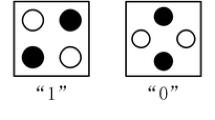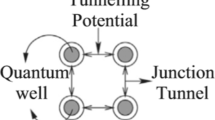Abstract
A novel fault-tolerant five-input majority gate for quantum-dot cellular automata is presented. Quantum-dot cellular automata (QCA) is an emerging technology which is considered to be presented in future computers. Two principle logic elements in QCA are “majority gate” and “inverter.” In this paper, we propose a new approach to the design of fault-tolerant five-input majority gate by considering two-dimensional arrays of QCA cells. We analyze fault tolerance properties of such block five-input majority gate in terms of misalignment, missing, and dislocation cells. Some physical proofs are used for verifying five-input majority gate circuit layout and functionality. Our results clearly demonstrate that the redundant version of the block five-input majority gate is more robust than the standard style for this gate.




Similar content being viewed by others
References
Armstrong CD, Humphreys WM (2003a) The development of design tools for fault tolerant quantum dot cellular automata based logic. 2nd international workshop on quantum dots for quantum computing and classical size effect circuits, University of Notre Dame, Notre Dame, 7–9 Aug 2003
Armstrong CD, Humphreys WM, Fijany A (2003b) The design of fault tolerant quantum dot cellular automata based logic. 11th NASA symposium on VLSI design, 28–29 May 2003
Azghadi MR, Kavehei O, Navi K (2007) A novel design for quantum-dot cellular automata cells and full-adders. J Appl Sci 7:3460–3468
Beard MJ (2006) Design and simulation of fault-tolerant quantum-dot cellular automata (QCA) NOT gates. M. S. Thesis, Wichita State University
Dalui M, Sen B, Sikdar BK (2010) Fault tolerant QCA logic design with coupled majority-minority gate. Int J Comput Appl 1(29):81–87
Dermott MC, Lillian C (1984) Research on conceptual understanding in mechanics. Phys Today 37(7):24–32
Farazkish R, Sayedsalehi S, Navi K (2012) Novel design for quantum dots cellular automata to obtain fault-tolerant majority gate. J Nanotechnol 2012(2012):1–7. doi:10.1155/2012/943406
Farazkish R, Azghadi MR, Navi K, Haghparast M (2008) New method for decreasing the number of quantum dot cells in QCA circuits. World Appl Sci J 6:793–802
Farazkish R, Khodaparast F, Navi K, Jalali A (2010) Design and characterization of a novel inverter for nanoelectronic circuits. International conference on nanotechnology: fundamentals and applications. Ottawa, Ontario, Canada, 4–6 Aug 2010, Paper No. 219
Fijany A, Toomarian BN (2001) J Nanopart Res 3:27–37
Halliday D, Resnick A (2004) Fundamentals of Physics Part 1 (Chapters 3–6), 7th edn. Wiley, New York
Halloun I, Hestenes D (1985) Common sense concepts about motions. Am J Phys 53:1056–1064
Huang J, Momenzadeh M, Tahoori MB, Lombardi F (2004) Design and characterization of an and-or-inverter (AOI). Gate for QCA implementation GLSVLSI, Boston, 26–28 Apr 2004
Lent CS, Tougaw PD (1993) Lines of interacting quantum-dot cells: a binary wire. J Appl Phys 74:6227–6233
Lent CS, Tougaw PD (1996) Dynamic behavior of quantum cellular automata. J Appl Phys 80(8):4722–4736
Navi K, Moayeri M, Faghih Mirzaee R, Hashemipour o, Mazloom Nezhad B (2009) Two new low-power full-adders based on majority-not gates. Microelectron J 40:126–130
Navi K, Farazkish R, Sayedsalehi S, Azghadi MR (2010a) A new quantum-dot cellular automata full-adder. Elsevier Microelectron J. doi:10.1016/j.mejo.2010.07.003
Navi K, Sayedsalehi S, Farazkish R, Azghadi MR (2010b) Five-input majority gate a new device for quantum-dot cellular automata. J Comput Theor Nanosci 7:1546–1553
Orlov AO, Amlani I, Bernstein GH, Lent CS, Snider GL (1997) Realization of a functional cell for quantum-dot cellular automata. Science 277:928–930
Sayedsalehi S, Moaiyeri MH, Navi K (2011) Novel efficient adder circuits for quantum-dot cellular automata. J Comput Theor Nanosci 8:1769–1775
Tougaw PD, Lent CS (1994) Logical devices implemented using quantum cellular automata. J Appl Phys 75:1818–1825
Zhang R, Walnut K, Wang W, Jullien G (2004) A method of majority logic reduction for quantum cellular automata. IEEE Trans Nanotechnol 3:443–450
Zhi H, Zhang Q, Haruehanroengra S, Wang W (2006) Logic optimization for majority gate based nanoelectronic circuits. In: Proceedings of international symposium on circuits and systems ISCAS, pp 1307–1310
Author information
Authors and Affiliations
Corresponding author
Rights and permissions
About this article
Cite this article
Farazkish, R., Navi, K. New efficient five-input majority gate for quantum-dot cellular automata. J Nanopart Res 14, 1252 (2012). https://doi.org/10.1007/s11051-012-1252-3
Received:
Accepted:
Published:
DOI: https://doi.org/10.1007/s11051-012-1252-3




